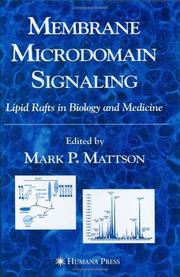| Listing 1 - 4 of 4 |
Sort by
|

ISBN: 9781588293541 1588293548 9781592598038 9786610358243 1280358246 159259803X Year: 2005 Publisher: Totowa, N.J. : Humana Press,
Abstract | Keywords | Export | Availability | Bookmark
 Loading...
Loading...Choose an application
- Reference Manager
- EndNote
- RefWorks (Direct export to RefWorks)
Lipid rafts-discrete regions in cell membranes that are rich in cholesterol and sphingolipids-are emerging not only as pivotal command and control centers for cellular signaling processes, but also as central to a wide array of human diseases, including immune disorders, diabetes, cardiovascular disease, and Alzheimer's disease. In Membrane Microdomain Signaling: Lipid Rafts in Biology and Medicine, multidisciplinary experts offer cutting-edge reviews of our current understanding of these membrane microdomains and their physiological and pathological roles. Here, readers will discover how lipid rafts change in cells over time and how they respond to various environmental signals, how cholesterol modulates the signaling function of lipid rafts, and how lipid rafts, the extracellular matrix, and the cell cytoskeleton structurally interact. Also described are the role of lipid rafts in learning, memory, and cancer, and as portals for endocytic uptake of an anticancer- and apoptotic alkyl-lysophospholipid. The authors also present emerging evidence that lipid rafts play critical roles in signaling pathways and the regulation of synaptic function in the nervous system, and that alterations in lipid raft metabolism are implicated in the pathogenesis of neurodegenerative disorders. They also describe techniques for the isolation of lipid rafts, the analysis of the lipid and protein components of lipid rafts, the imaging of lipid rafts in living cells, and the analysis of signal transduction in lipid rafts. Comprehensive and insightful, Membrane Microdomain Signaling: Lipid Rafts in Biology and Medicine offers researchers a multidisciplinary review of the latest basic, translational, and clinical research that promises to transform our understanding microdomain signaling mechanisms.
Membrane Microdomains --- Apoptosis --- Lipids --- Signal Transduction --- Synapses --- Membrane lipids --- Cellular signal transduction --- Lipides membranaires --- Transduction du signal cellulaire --- pathology --- physiology --- metabolism --- Apoptosis. --- Cellular signal transduction. --- Membrane lipids. --- Metabolism --- Physiology --- Lipid Metabolism --- Pathology --- Biochemical Processes --- Nervous System --- Cell Membrane Structures --- Metabolic Phenomena --- Chemicals and Drugs --- Cell Death --- Cell Physiological Processes --- Medicine --- Intercellular Junctions --- Biological Science Disciplines --- Phenomena and Processes --- Natural Science Disciplines --- Biochemical Phenomena --- Cell Membrane --- Cell Physiological Phenomena --- Chemical Processes --- Health Occupations --- Anatomy --- Cellular Structures --- Disciplines and Occupations --- Chemical Phenomena --- Cells --- Cytology --- Animal Biochemistry --- Human Anatomy & Physiology --- Biology --- Health & Biological Sciences --- Cellular information transduction --- Information transduction, Cellular --- Signal transduction, Cellular --- Life sciences. --- Cell biology. --- Life Sciences. --- Cell Biology. --- Bioenergetics --- Cellular control mechanisms --- Information theory in biology --- Membranes (Biology)

ISBN: 158829188X 9781588291882 Year: 2003 Publisher: Totowa: Humana press,
Abstract | Keywords | Export | Availability | Bookmark
 Loading...
Loading...Choose an application
- Reference Manager
- EndNote
- RefWorks (Direct export to RefWorks)
Aggression --- Neurobiology --- Socioeconomic Factors --- Aggressiveness --- Violence --- Physiological aspects. --- Social aspects. --- Treatment. --- Prevention.
Book
ISBN: 1607614944 1607614960 9786612830938 1607614952 1282830937 Year: 2010 Publisher: New York : Springer Science,
Abstract | Keywords | Export | Availability | Bookmark
 Loading...
Loading...Choose an application
- Reference Manager
- EndNote
- RefWorks (Direct export to RefWorks)
Hormesis is defined as any circumstance in which exposure of a cell or organism to a low dose of a substance or condition results in an adaptive stimulatory/beneficial outcome, while exposure to a high dose results in an inhibitory / detrimental outcome. When plotted on a graph the shape of the dose response curve is biphasic, the hallmark of hormesis. This groundbreaking book "Hormesis: A Revolution in Biology, Toxicology and Medicine" describes why and how hormesis is a fundamental feature of all living systems and is based on the evolutionary principle of selection for genetic traits that confer the ability to respond adaptively to adverse environmental conditions. Using numerous specific examples the authors explain why knowledge of hormesis is important for our health, our environment, and the future of our planet. Several chapters of the book describe emerging research findings that elucidate the molecular and cellular underpinnings of the biphasic dose response/hormesis. The implications of the tapping of cellular systems that underlie hormesis for the discovery and optimization of new drugs and dietary formulations are described. From environmental protection policy to medical practice, it is critical that leaders recognize and understand hormesis, and incorporate it into their decision making process. The authors propose that the prevention of major diseases, including diabetes, obesity and cardiovascular disease can be achieved using hormetic approaches. Scientists, physicians, environmental gurus and anyone interested in the science underlying biology and medicine will benefit from reading this book. Features Groundbreaking coverage of an oft experienced, but poorly understood phenomenon that affects all forms of life on earth. Explains why the principle of hormesis is important to our health, our environment, and the future of our planet. Provides specific examples of biphasic dose responses and their importance for the fields of biology, medicine and environmental safety. Discusses how knowledge of hormesis is being applied to research aimed understanding the organization and function of biological systems. Illustrates how disorders such as diabetes, obesity and cardiovascular disease result from the lack of exposure to beneficial environmental stresses. Considers the implications of the cellular systems that underlie hormesis for the discovery and optimization of new drugs and dietary formulations.
Ionizing radiation -- Dose-response relationship. --- Ionizing radiation -- Toxicology. --- Radiation carcinogenesis. --- Hormesis --- Dose-response relationship (Biochemistry) --- Adaptation, Biological --- Physiological Phenomena --- Physiological Processes --- Pharmacological Phenomena --- Adaptation, Physiological --- Pharmacological Processes --- Dose-Response Relationship, Drug --- Phenomena and Processes --- Biological Processes --- Biological Phenomena --- Human Anatomy & Physiology --- Public Health --- Biology --- Health & Biological Sciences --- Physiology --- Pharmacy, Therapeutics, & Pharmacology --- Toxicology & Public Health --- Cytology --- Low-level radiation --- Radiobiology. --- Physiological effect. --- Radiation, Low-level --- Radiation biology --- Medicine. --- Human physiology. --- Molecular biology. --- Neurosciences. --- Pharmacology. --- Biomedicine. --- Pharmacology/Toxicology. --- Molecular Medicine. --- Human Physiology. --- Biophysics --- Nuclear physics --- Radiation
Book
Year: 1986 Publisher: Ann Arbor: University microfilms,
Abstract | Keywords | Export | Availability | Bookmark
 Loading...
Loading...Choose an application
- Reference Manager
- EndNote
- RefWorks (Direct export to RefWorks)
| Listing 1 - 4 of 4 |
Sort by
|

 Search
Search Feedback
Feedback About UniCat
About UniCat  Help
Help News
News